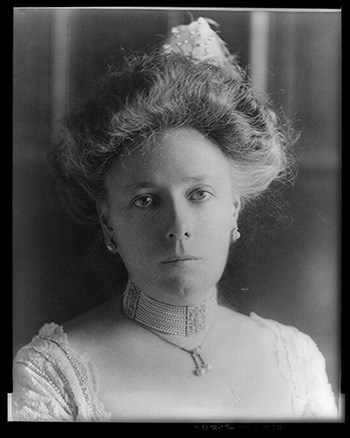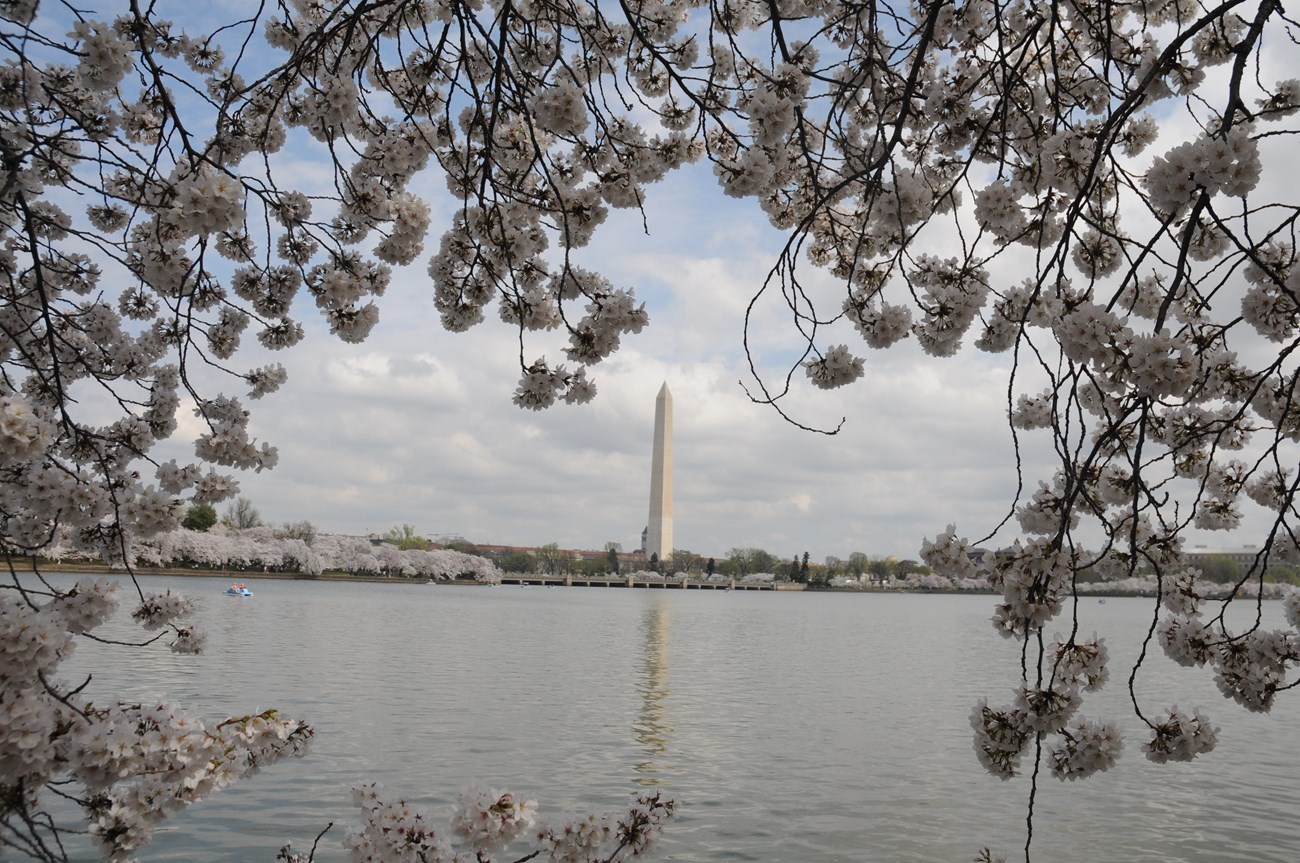Last updated: March 18, 2022
Article
New Beginnings: Cherry Blossoms and Helen Taft's Landscape Diplomacy

Library of Congress
Every spring, hundreds of thousands of visitors descend upon the Tidal Basin in Washington, D.C., during the Cherry Blossom Festival in order to capture images of the monuments framed by delicate blossoms of pink and white. What might now look like a fairy tale setting is the result of the vision First Lady Helen “Nellie” Herron Taft and an action of “landscape diplomacy.”
In 1901, Nellie traveled to the Philippines with her husband, then Governor General of the Philippines, William Howard Taft. In the capital city of Manila, she was introduced to the Lunete, a river park with a grand bandstands, gardens, and tree lined promenades where Manila’s elite would stroll in the evenings to see and be seen. The image of this iconic space remained with her. In 1909, shortly after her husband’s presidential inauguration, Nellie viewed the reclaimed tidal flats south of the Washington Monument as a potential site to develop as second Lunete for the citizens of the American capital.[1]
While previous efforts by the Office of Public Buildings and Grounds (OPBG) created the basin and implemented the original motorway and seawall, Nellie Taft contributed the vision of lining walkways, minor modifications to the form of the basin, more formal plantings, and the construction of a bandstand to host twilight concerts. Potomac Park became a fashionable destination for D.C. society to gather.[2]

Detroit Publishing Co., Library of Congress
While improvements were underway, the First Lady was approached by Dr. David Fairchild, a renowned plant explorer and United States Department of Agriculture (USDA) official, and Mrs. Eliza Scidmore, a Washington, D.C., socialite. They petitioned her to install cherry trees in Potomac Park. Fairchild advocated a grand avenue of cherries, while Scidmore championed a cluster of cherry trees along the edge of the Potomac River. On April 7, 1909, First Lady Taft enthusiastically responded in support of the effort.[3]
To begin, First Lady Taft directed the Superintendent of OPBG to purchase Japanese cherry trees to line the corridor of “The Speedway,” or modern day Independence Avenue, north of the Tidal Basin. Serendipitously, Dr. Jokichi Takamine, a celebrated Japanese chemist, happened to be in Washington D.C. the day after Nellie’s plans became public. At the same time, Japanese officials were working to strengthen ties between the two nations, including the attendance of a state dinner on April 4th, 1909.[4] Takamine notified the Japanese consul in New York, who arrived in Washington D.C. with a proposal to donate 2,000 cherry trees for the planting effort as a gesture of goodwill. The variety of trees species selected were to represent the different regions of the Japanese Empire.[5] The First Lady accepted. [6]
The Japanese gift of cherry trees arrived in Seattle, Washington in January of 1910.[7] An inspection of the trees by USDA officials revealed that they were infested with insects, nematodes, and diseases, requiring the saplings to be destroyed immediately. This created a tense diplomatic situation. The Secretary of State and the Japanese Ambassador became involved to resolve the issue. The plan they formed to save Japanese-American relations included a second donation from the citizens of Japan, grown in a more controlled environment, and shipped to the United States.

White House Photo Office Collection, National Archives
In 1912, the second shipment of cherry trees arrived from Japan with a personal letter to First Lady Taft from the Mayoress of Tokyo. Yei Theodora Ozaki wrote that her husband, The Mayor of Tokyo, “ hopes [the trees] will form an avenue in Washington as a memorial of national friendship between the U.S. and Japan.” She wished that the trees would serve as a visual reminder of Japanese devotion and admiration, “for her old friend and tutor, America.”[8] On March 27th, 1912, First Lady Helen Taft and Viscountess Iwa Chinda, the wife of the Japanese Ambassador, planted the first two cherry trees on the northern edge of the Tidal Basin, to be followed by many more. The ceremony was simple, but created a lasting impact.[9]
The cherry trees as “landscape diplomacy” have symbolized positive Japanese-American relations again and again over the century since Nellie Taft’s first planting. In the aftermath of World War II, the National Park Service provided budwood from the cherry trees in order to help restore the original grove of the Adachi Ward in Tokyo. First Lady Claudia “Lady Bird” Johnson and Mrs. Ryuji Takeuchi, wife of the Japanese Ambassador, recreated the ceremony of the first planting in 1965 with a donation of almost 4000 cherry trees from Japan to the United States.[10] First Lady Michelle Obama and the Japanese Ambassador again planted trees in 2012 to represent the friendship of the two nations.[11] The actions and forethought of Helen Taft established a precedence of the position of First Lady using the landscape as a diplomatic tool, forged Japanese American relations, and created a beloved Washington icon.
[1] “ Mrs. Taft’s Esplanade A Hit In Washington,” The Leavenworth Weekly Times (Leavenworth, Kansas) April 15th, 1909.
[2] “Potomac Park,” The National Tribune (Washington, D.C.) April 22,1909.
[3] The NACC Cherry Tree Sourcebook (The National Park Service, 1996), 4.
[4] “Japanese Envoys Here: High Officials of Tokyo Expositioned Are in Town,” The Washington Post (Washington, D.C.) April 5th, 1909
[5] “Her Labor of Love” Evening Star (Washington, D.C.) Dec 31, 1909
[6] The NACC Cherry Tree Sourcebook (The National Park Service, 1996), 5.
[7]“Japanese Cherry Trees Presented Mrs. Taft.” Mt Sterling Advocate (Mt. Sterling, KY) Jan 19, 1910.
[8] Yei Theodora Ozaki, letter to First Lady Helen Taft, February 26th, 1912.
[9] “Blooms from Japan: Three Thousand Trees Capable of Luxuriant Growth” The Sunday Star (Washington, D.C.) March 31,1912.
[10] The NACC Cherry Tree Sourcebook (The National Park Service, 1996), 6.
[11] Michael E. Ruane “ Michelle Obama reenacts first cherry tree planting,” The Washington Post (Washington, D.C.) March 27th, 2012.
Tags
- national mall and memorial parks
- cultural landscape
- washington d.c.
- cherry blossoms
- national mall and memorial parks
- ncr
- new beginnings
- women's history
- first ladies
- japan
- tidal basin
- spring
- helen taft
- featured article
- women and the environment
- women of the nps
- historic women of the nps
- engaging the environment
- international relations
- political history
- nca




